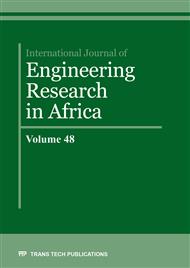[1]
N. Ghorbani, A. Kasaeian, A. Toopshekan and L. Bahrami, Optimization a hybrid wind-PV-battery system using GA-PSO and MOPSO for reducing cost and increasing reliability, Energy. 154 (2018) 581–591.
DOI: 10.1016/j.energy.2017.12.057
Google Scholar
[2]
M. Moghaddam, A. Kalama, S. Nowdeh, A. Ahmadi, M. Babanezhad and S. Saha, Optimal sizing and energy management of stand-alone hybrid photovoltaic/wind system based on hydrogen storage considering LOEE and LOLE reliability indices using flower pollination algorithm, Renewable energy. 135 (2019) 1412–1434.
DOI: 10.1016/j.renene.2018.09.078
Google Scholar
[3]
M. Das, Maisanam A. Singh and A. Biswas, Techno-economic optimization of an off-grid hybrid renewable energy system using metaheuristic optimization approaches – Case of a radio transmitter station in India, Energy conversion and managementh. 185 (2019) 339-352.
DOI: 10.1016/j.enconman.2019.01.107
Google Scholar
[4]
K. Chang and G. Lin, Optimal design of hybrid renewable energy systems using simulation optimization, Simulation Modelling Practice and Theory. 52 (2015) 40-51.
DOI: 10.1016/j.simpat.2014.12.002
Google Scholar
[5]
K. Lee, D. Lee, N. Baek, H. Kwon and C. Lee, Preliminary determination of optimal size for renewable energy resources in buildings using RETScreen, Energy. 47 (2012) 83-96.
DOI: 10.1016/j.energy.2012.08.040
Google Scholar
[6]
W. Zhang, A. Maleki, M.A. Rosen and J. Lui, Sizing a stand-alone solar-wind-hydrogen energy system using weather forecasting and a hybrid search optimization algorithm, Energy Conversion and Management. 180 (2019) 609-621.
DOI: 10.1016/j.enconman.2018.08.102
Google Scholar
[7]
M. Ming, R. Wang, Y. Zha and T. Zhang, Multi-Objective Optimization of Hybrid Renewable Energy System Using an Enhanced Multi-Objective Evolutionary Algorithm, Energies. 10 (2017) 674.
DOI: 10.3390/en10050674
Google Scholar
[8]
L. Olatomiwa, R. Blanchard, S. Mekhilef and D. Akinyele, Hybrid renewable energy supply for rural healthcare facilities: An approach to quality healthcare delivery, Sustainable Energy and Assessments. 30 (2018) 121-138.
DOI: 10.1016/j.seta.2018.09.007
Google Scholar
[9]
R. Lamedica, E. Santini, A. Ruvio, L. Palagi and I. Rossetta, A MILP methodology to optimize sizing of PV-Wind renewable energy systems, Energy. 165 (2018) 385-398.
DOI: 10.1016/j.energy.2018.09.087
Google Scholar
[10]
A.M. Hemeida, M.H. El-Ahmar, A.M. El-Sayed, H.M. Hasanien, S. Alkhalaf, M.F.C. Esmail and T. Senjyu, Optimum design of hybrid wind/PV energy system for remote area, Ain Shams Engineering Journal. 11 (2020) 11-23.
DOI: 10.1016/j.asej.2019.08.005
Google Scholar
[11]
R.A. Gupta, R. Kumar and A.K. Bansal, BBO-based small autonomous hybrid power system optimization incorporating wind speed and solar radiation forecasting, Renewable and Sustainable Energy Reviews. 41 (2015) 1366-1375.
DOI: 10.1016/j.rser.2014.09.017
Google Scholar
[12]
M. Jayachandran and G. Ravi, Design and optimization of hybrid micro-grid system, Energy Procedia. 117 (2017) 95-103.
DOI: 10.1016/j.egypro.2017.05.111
Google Scholar
[13]
Help files of the software Homer, National Renewable Energy Laboratory (NREL), 617 Cole Boulevard, Golden, CO 80401-3393; Information on www.nrel.gov/homer.
DOI: 10.2172/1092621
Google Scholar
[14]
A. Bin, Y. Hongxing, H. Shen and L. Xianbo, Computer aided design for PV/Wind hybrid system, Renewable Energy. 28 (2003) 1491-1512.
DOI: 10.1016/s0960-1481(03)00011-9
Google Scholar
[15]
Information on http://eosweb.larc.nasa.gov/sse.
Google Scholar
[16]
Information on www.bergey.com.
Google Scholar
[17]
Information on www.rollsbattery.com.
Google Scholar
[18]
M.D.A. Al-falahi, S.D.G. Jayasinghe and H. Enshaei, A review on recent size optimization methodologies for standalone solar and wind hybrid renewable energy system, Energy Conversion and Management. 51 (2017) 252-274.
DOI: 10.1016/j.enconman.2017.04.019
Google Scholar
[19]
S. Sinha and S.S. Chandel, Review of recent trends in optimization techniques for solar photovoltaic-wind based hybrid energy systems, Renewable and Sustainable Energy Reviews. 50 (2015) 755-769.
DOI: 10.1016/j.rser.2015.05.040
Google Scholar


